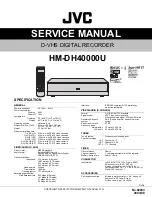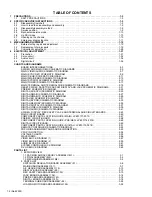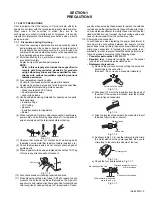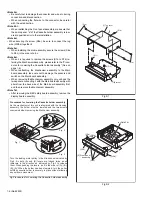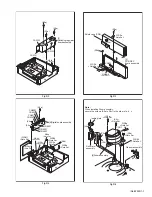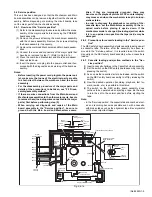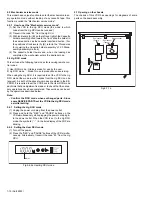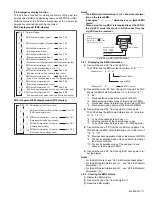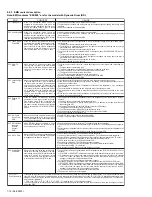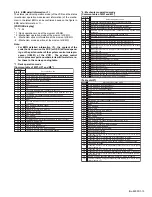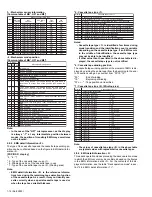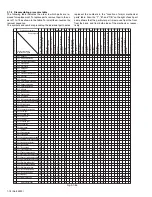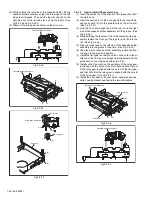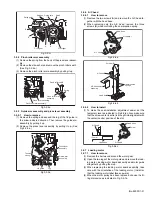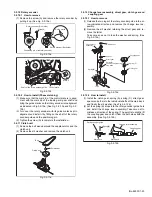
(No.82933)1-9
2.4 Service position
This unit has been designed so that the Mechanism and Main
board assemblies can be removed together from the chassis as-
sembly. Before diagnosing or servicing the circuit boards, take
out the major parts from the chassis assembly.
2.4.1 How to set the “Service position”
(1) Refer to the disassembly procedure and perform the disas-
sembly of the major parts before removing the PRE/REC
board assembly.
(2) Remove the screws attaching the mechanism assembly
with the chassis assembly. Remove the screws attaching
the board assembly, if necessary.
(3) Remove the combined Mechanism and Main board assem-
blies.
(4) Connect the wires and connectors of the major parts that
have been removed in step (1). (Refer to Fig.2-4-1a.)
(5) Place the combined Mechanism and Main board assem-
blies upside down.
(6) Insert the power cord plug into the power outlet and then-
proceed with the diagnostics and servicing of the board as-
sembly.
Notes:
•
Before inserting the power cord plug into the power out-
let, make sure that none of the electrical parts are able
to short-circuit between the workbench and the board
assembly.
•
For the disassembly procedure of the major parts and
details of the precautions to be taken, see “2.3 Disas-
sembly/assembly method”.
•
If there are wire connections from the Main board and
Mechanism assemblies to the other major parts, besure
to remove them ( including wires connected to the major
parts ) first before performing step (2).
•
When carrying out diagnosis and repair of the Main
board assembly in the “Service position”, be sure to
ground both the Main board and Mechanism assem-
blies. If they are improperly grounded, there may
benoise on the playback picture or FDP counter display-
may move even when the mechanism is kept in an inop-
erative status.
•
In order to diagnose the playback or recording of the-
cassette tape, set the Mechanism assembly to the re-
quired mode before placing it upside down. If the
mechanism mode is changed (including ejection) while
it is in an upside down position the tape inside may be
damaged.
2.4.2 Precautions for cassette loading in the “Service posi-
tion”
The REC safety board assembly detects cassette loading as well
as cassette tabs. Therefore, after the assembly has been re-
moved in the “Service position”, it is required to set the switch
manually on the REC safety board assembly when a cassette is
loaded.
2.4.3 Cassette loading and ejection methods in the “Ser-
vice position”
(1) Insert a cassette halfway in the Cassette holder assembly.
(2) Set the switch on the REC safety board assembly to on (by
pressing the switch).
(3) As soon as the cassette starts to be loaded, set the switch
on the REC safety board assembly to off (by releasing the
switch).
(4) Now the desired operation (recording, playback, fast for-
ward, rewind, etc.) is possible in this status.
(5) The switch on the REC safety board assembly does
nothave to be operated when ejecting a tape. But be sure
to turn the set to the normal position before ejecting the
tape.
Note:
• In the “Service position”, the cassette tabs cannot be detect-
ed and recording becomes possible even with a cassette
with broken tabs such as the alignment tape. Be verycareful
not to erase important tapes.
Fig.2-4-1a
Jack board
assembly
Display board assembly
CP4001
CP3002
Main board assembly
Switching regulator
board assembly
TP4001
CTL P
TP2253
A.PB FM
TP111
D.FF
TP106
PB FM
TP2254
A.REC FM
VR2251
FMA
REC
LEVEL
TP501
Y TO SE
Digital
board assembly
PRE/REC
board assembly
CN7005
CN7002
REC Safety
board assembly
Terminal sub board assembly
CN3009
CN7017
CN7191
CN8001
CN8002
TO CN8002
TO CN8001
CN9001
CN9301
CN8005
CN8003
CN8004
CN8801
CN901
CN401
CN402
CN3008
CN5603
CN601
CN602
CN7104
CN7101
CN7102
TP622 TP612
TP621 TP602 T611
TP611
REC_LEVEL1
TP621
PB_DATA1
TP602
A/HS2_FF
TP622
PB_DATA2
TP612
REC_LEVEL2



